Available with Location Referencing license.
The Translate tool allows you to translate between route ID and route name as well as line ID and line name. These can be used interchangeably to translate the ID or name. Measures can also be translated between coincident or intersecting routes of the same or different networks.
Translate measures scenario
In the following example, the Measures option is used to translate a measure on a route in an engineering network to a coincident measure on a derived route in a continuous network:
The From Network measure is on the eastbound route (Hwy 20 East), which has a coincident measure on the To Network westbound route (Hwy 20 West).
Choosing Hwy 20 East at measure 15 results in a translated measure of 12 on Hwy 20 West.
Translate routes
Complete the following steps to translate between a route name value and a route ID value:
Tip:
You can get more detailed route information
using the Identify Routes tool  .
.
- Open the map that contains the network that has the route with the name you want to translate.
Routes in all of the LRS Networks in the Contents pane are available to translate, except networks configured with single-field or multifield route ID.
- Zoom in to the location of the route with the route name or route ID to translate.
- On the Location Referencing tab, in the Tools group, click Translate
 .
.The Translate dialog box appears. The Routes button is chosen by default.
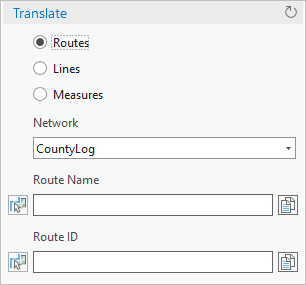
- Choose the network that contains the route with the name to translate from the Network drop-down list.
- Provide a route name or route ID by doing one of the following:
- Click the Choose route from map button
 for either Route Name or Route ID.
for either Route Name or Route ID. - Type the route name in the Route Name or Route ID text box. If the value provided is invalid, an error occurs.
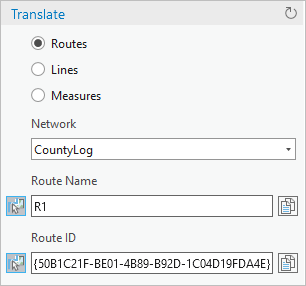
When the route is selected, it flashes on the map and its values populate the dialog box.
- Click the Choose route from map button
- Optionally, click Copy to clipboard to save the route name or route ID for separate use.
Translate lines
Complete the following steps to translate a line name value to a line ID value:
- Open the map that contains the line network with the line name to translate.
- Zoom in to the location of the routes with the line name or line ID to translate.
- On the Location Referencing tab, in the Tools group, click Translate
 .
.The Translate dialog box appears.
- Click the Lines button.
The line-related text boxes appear on the Translate dialog box.
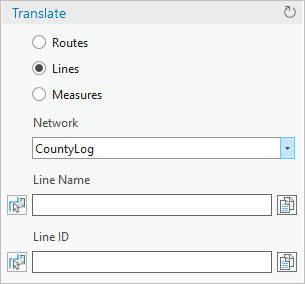
- Provide a line name or line ID to translate by doing one of the following:
- Click the Choose line from map button
 for either Line Name or Line ID.
for either Line Name or Line ID. - Type the line name or line ID in the Line Name or Line ID text box. If the value provided is invalid, an error occurs.

Note:
After clicking Choose route from map
 , move the pointer over the line and select it.
, move the pointer over the line and select it.Once the line is populated, it flashes on the map.
- Click the Choose line from map button
- Optionally, click Copy to clipboard to save the line name or line ID for separate use.
Translate measures
Complete the following steps to locate the provided measure on a coincident or intersecting route:
Tip:
You can also get the location of routes and measures using the Locate Route and Measures tool.
- Open the map that contains the network that is the source of the measure to translate.
- On the Location Referencing tab, in the Tools group, click Translate
 .
.The Translate dialog box appears with the Route button chosen by default.
- Click the Measures button.
The measure-related fields appear on the Translate dialog box.
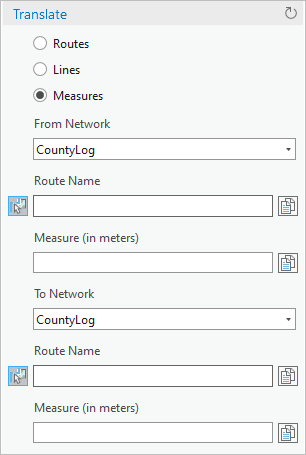
- Choose the network that will provide the measure to translate from the From Network drop-down list.
If the network has been configured to use a single-field route ID, the RouteID option appears.
- In the From Network section, choose the measure to translate by doing one of the following.
- Click the Choose route from map button
 for Route Name.
for Route Name. - Type the route ID in the Route Name text box. If the value provided is invalid, an error occurs.
The To Network measure is populated if the value is from the from network.
- Click the Choose route from map button
- Choose the target network that contains the coincident measure from the To Network drop-down list if necessary.
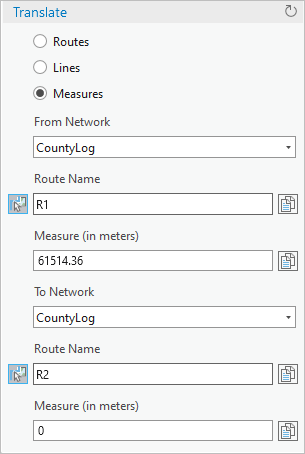
- Optionally, click Copy to clipboard to save either measure for separate use.